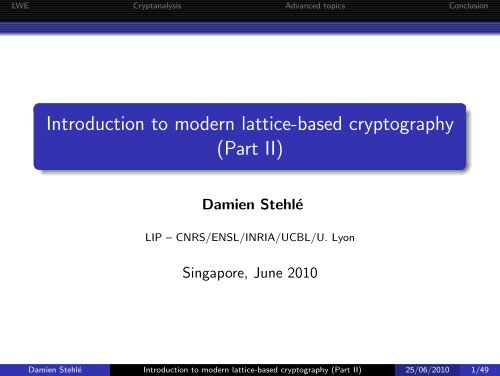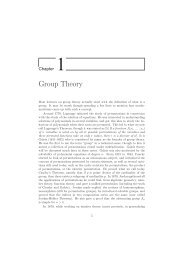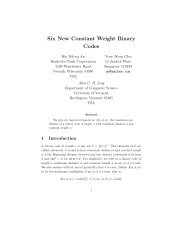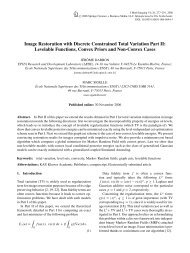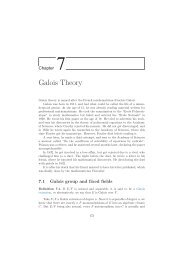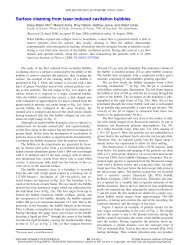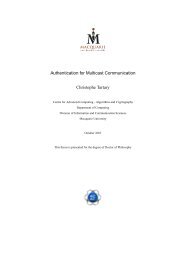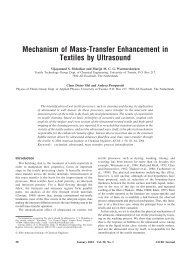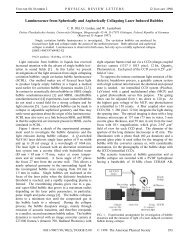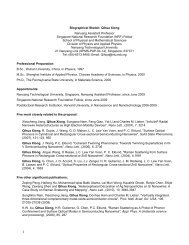Introduction to modern lattice-based cryptography (Part II) - Spms
Introduction to modern lattice-based cryptography (Part II) - Spms
Introduction to modern lattice-based cryptography (Part II) - Spms
Create successful ePaper yourself
Turn your PDF publications into a flip-book with our unique Google optimized e-Paper software.
LWE Cryptanalysis Advanced <strong>to</strong>pics Conclusion<br />
<strong>Introduction</strong> <strong>to</strong> <strong>modern</strong> <strong>lattice</strong>-<strong>based</strong> cryp<strong>to</strong>graphy<br />
(<strong>Part</strong> <strong>II</strong>)<br />
Damien Stehlé<br />
LIP – CNRS/ENSL/INRIA/UCBL/U. Lyon<br />
Singapore, June 2010<br />
Damien Stehlé <strong>Introduction</strong> <strong>to</strong> <strong>modern</strong> <strong>lattice</strong>-<strong>based</strong> cryp<strong>to</strong>graphy (<strong>Part</strong> <strong>II</strong>) 25/06/2010 1/49
LWE Cryptanalysis Advanced <strong>to</strong>pics Conclusion<br />
Plan<br />
1- Background on Euclidean <strong>lattice</strong>s.<br />
2- The SIS problem, or how <strong>to</strong> hash.<br />
3- The LWE problem, or how <strong>to</strong> encrypt.<br />
4- Cryptanalysis.<br />
5- Advanced <strong>to</strong>pics: IBE and FHE.<br />
Damien Stehlé <strong>Introduction</strong> <strong>to</strong> <strong>modern</strong> <strong>lattice</strong>-<strong>based</strong> cryp<strong>to</strong>graphy (<strong>Part</strong> <strong>II</strong>) 25/06/2010 2/49
LWE Cryptanalysis Advanced <strong>to</strong>pics Conclusion<br />
The LWE problem<br />
a- Non structured LWE.<br />
b- Structured LWE.<br />
c- Encrypting with LWE.<br />
Damien Stehlé <strong>Introduction</strong> <strong>to</strong> <strong>modern</strong> <strong>lattice</strong>-<strong>based</strong> cryp<strong>to</strong>graphy (<strong>Part</strong> <strong>II</strong>) 25/06/2010 3/49
LWE Cryptanalysis Advanced <strong>to</strong>pics Conclusion<br />
LWE α,q [Regev’05]<br />
Let s ∈ Z n q. Let Σ s,α be the distribution corresponding <strong>to</strong>:<br />
(a; 〈a,s〉 + e [q]) , with a ←֓ U(Z n q), e ←֓ ν αq (small Gaussian).<br />
The Learning With Errors Problem — Comp-LWE α<br />
Let s ∈ Z n q. Given arbitrarily many samples from Σ s,α , find s.<br />
arb.<br />
n<br />
+<br />
A s<br />
uniform uniform<br />
e<br />
small<br />
Many interpretations:<br />
Learning problem, like LPN (over Z 2 ).<br />
Approximate linear algebra.<br />
Closest codeword problem.<br />
Lattice problem . . .<br />
Damien Stehlé <strong>Introduction</strong> <strong>to</strong> <strong>modern</strong> <strong>lattice</strong>-<strong>based</strong> cryp<strong>to</strong>graphy (<strong>Part</strong> <strong>II</strong>) 25/06/2010 4/49
LWE Cryptanalysis Advanced <strong>to</strong>pics Conclusion<br />
LWE as a one-way function<br />
OWF: easy <strong>to</strong> evaluate and hard <strong>to</strong> invert.<br />
LWE’s OWF: s ∈ Z n q ↦→ As + e [q].<br />
A one-way function with trapdoor.<br />
Generate A <strong>to</strong>gether with T A .<br />
T A · (As + e) = T A · e [q].<br />
Both T A and e are small ⇒ we know T A · e over Z.<br />
We recover e and then s by linear algebra.<br />
Sufficient condition:<br />
q<br />
2 > √ nαq · max ‖t i ‖ ⇐ n 1.5 α = õ(1).<br />
Damien Stehlé <strong>Introduction</strong> <strong>to</strong> <strong>modern</strong> <strong>lattice</strong>-<strong>based</strong> cryp<strong>to</strong>graphy (<strong>Part</strong> <strong>II</strong>) 25/06/2010 5/49
LWE Cryptanalysis Advanced <strong>to</strong>pics Conclusion<br />
LWE as a <strong>lattice</strong> problem<br />
Comp-LWE α<br />
Let s ∈ Z n q. Given (A; As + e [q]) with A ←֓ U(Z m×n<br />
q ) and<br />
e ←֓ ναq m for arbitrary m, find s.<br />
Let L A = {b ∈ Z m : ∃x ∈ Z n q, b = Ax [q]}.<br />
L A is an m-dimensional <strong>lattice</strong> and ̂L A = 1 q A⊥ .<br />
BDD α,q (bounded distance decoding):<br />
Take A ←֓ U(Z m×n<br />
q ), e ←֓ ναq m and b ∈ L A arbitrary. Given A<br />
and b + e, find b.<br />
If we can solve LWE, then we can solve BDD.<br />
Damien Stehlé <strong>Introduction</strong> <strong>to</strong> <strong>modern</strong> <strong>lattice</strong>-<strong>based</strong> cryp<strong>to</strong>graphy (<strong>Part</strong> <strong>II</strong>) 25/06/2010 6/49
LWE Cryptanalysis Advanced <strong>to</strong>pics Conclusion<br />
How hard is LWE<br />
Quantum worst-case <strong>to</strong> average-case reduction<br />
(γ ≈ n/α)<br />
Any efficient LWE algorithm succeeding with non-negligible<br />
probability leads <strong>to</strong> an efficient quantum SIVP algorithm.<br />
Efficient quantum computers make LWE more secure!<br />
[Peikert’09] de-quantumized the reduction, for large q.<br />
[SSTX’09]: simpler (but weaker) quantum reduction.<br />
Damien Stehlé <strong>Introduction</strong> <strong>to</strong> <strong>modern</strong> <strong>lattice</strong>-<strong>based</strong> cryp<strong>to</strong>graphy (<strong>Part</strong> <strong>II</strong>) 25/06/2010 7/49
LWE Cryptanalysis Advanced <strong>to</strong>pics Conclusion<br />
How hard is BDD α,q Rough intuition.<br />
L −→ ˆL<br />
Fourier transform<br />
The Fourier transform of the distribution is implemented with<br />
the quantum Fourier transform.<br />
The input quantum state is built with the LWE oracle.<br />
The measurement gives a small SIS solution.<br />
Damien Stehlé <strong>Introduction</strong> <strong>to</strong> <strong>modern</strong> <strong>lattice</strong>-<strong>based</strong> cryp<strong>to</strong>graphy (<strong>Part</strong> <strong>II</strong>) 25/06/2010 8/49
LWE Cryptanalysis Advanced <strong>to</strong>pics Conclusion<br />
Decisional LWE<br />
Σ s,α : (a; 〈a,s〉 + e [q]) with a ←֓ U(Z n q), e ←֓ ν αq .<br />
Comp-LWE α<br />
Let s ∈ Z n q. Given arbitrarily many samples from Σ s,α , find s.<br />
Dec-LWE α<br />
Let s ←֓ U(Z n q). Distinguish between (arbitrarily many) samples<br />
from Σ s,α or from U(Z 2 q).<br />
Dec-LWE and Comp-LWE efficiently reduce <strong>to</strong> each other.<br />
Damien Stehlé <strong>Introduction</strong> <strong>to</strong> <strong>modern</strong> <strong>lattice</strong>-<strong>based</strong> cryp<strong>to</strong>graphy (<strong>Part</strong> <strong>II</strong>) 25/06/2010 9/49
LWE Cryptanalysis Advanced <strong>to</strong>pics Conclusion<br />
The LWE problem<br />
a- Non structured LWE.<br />
b- Structured LWE.<br />
c- Encrypting with LWE.<br />
Damien Stehlé <strong>Introduction</strong> <strong>to</strong> <strong>modern</strong> <strong>lattice</strong>-<strong>based</strong> cryp<strong>to</strong>graphy (<strong>Part</strong> <strong>II</strong>) 25/06/2010 10/49
LWE Cryptanalysis Advanced <strong>to</strong>pics Conclusion<br />
Ideal LWE<br />
Let R q = Z q [x]/(x n + 1) with n = 2 k and q prime.<br />
Let Ψ ≤αq be the set of ellipsoidal Gaussians (ν ri ) i in R n ,<br />
where each component has standard deviation r i ≤ αq.<br />
For ψ ∈ Ψ ≤αq and s ∈ R q , we define:<br />
Σ Id<br />
s,ψ : (a; as + e [q]) with a ←֓ U(R q), e ←֓ ψ.<br />
Comp-Id-LWE α<br />
Let s ∈ R q and ψ ∈ Ψ ≤αq . Given arbitrarily many samples from<br />
, find s.<br />
Σ Id<br />
s,ψ<br />
One sample from Σ Id encodes n samples from Σ.<br />
But it costs about the same as 1 sample from Σ:<br />
We use R q <strong>to</strong> multiply vec<strong>to</strong>rs, with FFT!<br />
Same matrix interpretation, but with negacylic blocks.<br />
Damien Stehlé <strong>Introduction</strong> <strong>to</strong> <strong>modern</strong> <strong>lattice</strong>-<strong>based</strong> cryp<strong>to</strong>graphy (<strong>Part</strong> <strong>II</strong>) 25/06/2010 11/49
LWE Cryptanalysis Advanced <strong>to</strong>pics Conclusion<br />
Ideal LWE is hard<br />
Σ Id<br />
s,ψ : (a; as + e [q]) with a ←֓ U(R q), e ←֓ ψ.<br />
Comp-Id-LWE α<br />
Let s ∈ R q and ψ ∈ Ψ ≤αq . Given arbitrarily many samples from<br />
, find s.<br />
Σ Id<br />
s,ψ<br />
Any efficient Id-LWE algo. succeeding with non-negligible<br />
probability leads <strong>to</strong> an efficient quantum Id-SIVP algo.<br />
Damien Stehlé <strong>Introduction</strong> <strong>to</strong> <strong>modern</strong> <strong>lattice</strong>-<strong>based</strong> cryp<strong>to</strong>graphy (<strong>Part</strong> <strong>II</strong>) 25/06/2010 12/49
LWE Cryptanalysis Advanced <strong>to</strong>pics Conclusion<br />
A faster trapdoor one-way function<br />
Evaluation cost: Õ(n 2 ) ⇒ Õ(n) bit operations.<br />
For the inversion, use the structured T A from Id-SIS.<br />
T A · (As + e) = T A e over the integers.<br />
Multiply by T −1<br />
A<br />
<strong>to</strong> recover e, and then s.<br />
Evaluation/inversion cost: Õ(n 2 ) ⇒ Õ(n) bit operations.<br />
Damien Stehlé <strong>Introduction</strong> <strong>to</strong> <strong>modern</strong> <strong>lattice</strong>-<strong>based</strong> cryp<strong>to</strong>graphy (<strong>Part</strong> <strong>II</strong>) 25/06/2010 13/49
LWE Cryptanalysis Advanced <strong>to</strong>pics Conclusion<br />
Decisional Ideal LWE<br />
Σ Id<br />
s,ψ : (a; as + e [q]) with a ←֓ U(R q), e ←֓ ψ.<br />
Comp-Id-LWE α<br />
Let s ∈ R q and ψ ∈ Ψ ≤αq . Given arbitrarily many samples from<br />
, find s.<br />
Σ Id<br />
s,ψ<br />
Dec-Id-LWE α<br />
Let s ←֓ U(R q ) and ψ ∈ Ψ ≤αq , choosing the st. devs. from an<br />
exponential variate. Distinguish between (arbitrarily many)<br />
samples from Σ Id<br />
s,ψ or from U(R2 q).<br />
If x n + 1 has n fac<strong>to</strong>rs modulo q, then Dec-Id-LWE and<br />
Comp-Id-LWE efficiently reduce <strong>to</strong> each other.<br />
Damien Stehlé <strong>Introduction</strong> <strong>to</strong> <strong>modern</strong> <strong>lattice</strong>-<strong>based</strong> cryp<strong>to</strong>graphy (<strong>Part</strong> <strong>II</strong>) 25/06/2010 14/49
LWE Cryptanalysis Advanced <strong>to</strong>pics Conclusion<br />
The LWE problem<br />
a- Non structured LWE.<br />
b- Structured LWE.<br />
c- Encrypting with LWE.<br />
Damien Stehlé <strong>Introduction</strong> <strong>to</strong> <strong>modern</strong> <strong>lattice</strong>-<strong>based</strong> cryp<strong>to</strong>graphy (<strong>Part</strong> <strong>II</strong>) 25/06/2010 15/49
LWE Cryptanalysis Advanced <strong>to</strong>pics Conclusion<br />
Encrypting with LWE<br />
A ′ e ′ + ⌊ q 2 ⌋ · M<br />
A<br />
+<br />
s e<br />
Public key: A ∈ Z m×n<br />
q , A ′ ∈ Z n×n<br />
q ; secret key: T A .<br />
Encryption: compute [As + e; A ′ s + e ′ + ⌊ q 2 ⌋ · M].<br />
Decryption: recover s from the first part of the ciphertext,<br />
using T A ; compute A ′ s <strong>to</strong> obtain e ′ + ⌊ q 2<br />
⌋M; round <strong>to</strong> the<br />
closest multiple of ⌊ q 2<br />
⌋ <strong>to</strong> recover M.<br />
Any semantic attack leads <strong>to</strong> an algorithm for Dec-LWE.<br />
Damien Stehlé <strong>Introduction</strong> <strong>to</strong> <strong>modern</strong> <strong>lattice</strong>-<strong>based</strong> cryp<strong>to</strong>graphy (<strong>Part</strong> <strong>II</strong>) 25/06/2010 16/49
LWE Cryptanalysis Advanced <strong>to</strong>pics Conclusion<br />
Encrypting with Id-LWE<br />
We could do the same . . . but there is much better.<br />
Σ Id<br />
s,ψ : (a; as + e [q]) with a ←֓ U(R q), e ←֓ ψ.<br />
Let s ←֓ U(R q ) and ψ “small”. Distinguishing between samples<br />
from Σ Id<br />
s,ψ or from U(R2 q) is computationally infeasible.<br />
Simplification: We can also take s small.<br />
The transformation (a i , b i ) ֒→ (a i<br />
, b i<br />
− a −1<br />
1 b 1 ) maps:<br />
U(R 2 q) <strong>to</strong> U(R 2 q) and Σ Id U(R q),ψ <strong>to</strong> ΣId ψ,ψ .<br />
Damien Stehlé <strong>Introduction</strong> <strong>to</strong> <strong>modern</strong> <strong>lattice</strong>-<strong>based</strong> cryp<strong>to</strong>graphy (<strong>Part</strong> <strong>II</strong>) 25/06/2010 17/49
LWE Cryptanalysis Advanced <strong>to</strong>pics Conclusion<br />
Encrypting with Id-LWE<br />
Σ Id<br />
s,ψ : (a; as + e [q]) with a ←֓ U(R q), e ←֓ ψ.<br />
Let s and ψ “small”. Distinguishing between samples from Σ Id<br />
s,ψ or<br />
from U(R 2 q) is computationally infeasible.<br />
Secret key: s (small); Public key: a 1 , a 2 = a 1 s + e.<br />
Encryption: (c 1 , c 2 ) = (a 1 t + e 1 , a 2 t + e 2 + ⌊ q 2 ⌋M),<br />
with t random and small.<br />
Decryption: c 2 − c 1 s is “small +⌊ q 2 ⌋M”.<br />
CPA-secure assuming the hardness of Dec-Id-LWE.<br />
Key-sizes are quasi-optimal.<br />
Complexity and ciphertext expansion are quasi-optimal.<br />
Damien Stehlé <strong>Introduction</strong> <strong>to</strong> <strong>modern</strong> <strong>lattice</strong>-<strong>based</strong> cryp<strong>to</strong>graphy (<strong>Part</strong> <strong>II</strong>) 25/06/2010 18/49
LWE Cryptanalysis Advanced <strong>to</strong>pics Conclusion<br />
This is ElGamal!!!<br />
Secret key: s (small); Public key: a 1 , a 2 = a 1 s + e.<br />
Encryption: (c 1 , c 2 ) = (a 1 t + e 1 , a 2 t + e 2 + ⌊ q 2 ⌋M),<br />
with t random and small.<br />
Decryption: c 2 − c 1 s is “small +⌊ q 2 ⌋M”.<br />
Secret key: s; Public key: g 1 , g 2 = g s 1 .<br />
Encryption: (c 1 , c 2 ) = (g1 t, gt 2M), with t random.<br />
Decryption: c 2 /c1 s is M.<br />
Damien Stehlé <strong>Introduction</strong> <strong>to</strong> <strong>modern</strong> <strong>lattice</strong>-<strong>based</strong> cryp<strong>to</strong>graphy (<strong>Part</strong> <strong>II</strong>) 25/06/2010 19/49
LWE Cryptanalysis Advanced <strong>to</strong>pics Conclusion<br />
Plan<br />
1- Background on Euclidean <strong>lattice</strong>s.<br />
2- The SIS problem, or how <strong>to</strong> hash.<br />
3- The LWE problem, or how <strong>to</strong> encrypt.<br />
4- Cryptanalysis.<br />
5- Advanced <strong>to</strong>pics: IBE and FHE.<br />
Damien Stehlé <strong>Introduction</strong> <strong>to</strong> <strong>modern</strong> <strong>lattice</strong>-<strong>based</strong> cryp<strong>to</strong>graphy (<strong>Part</strong> <strong>II</strong>) 25/06/2010 20/49
LWE Cryptanalysis Advanced <strong>to</strong>pics Conclusion<br />
Attacking SIS/Id-SIS/LWE/Id-LWE<br />
The only known attack consists in finding a small vec<strong>to</strong>r/basis<br />
of the <strong>lattice</strong> A ⊥ = {s ∈ Z mn : sA = 0 [q]}.<br />
Generalized birthday attack: may be feasible if m is large.<br />
Its cost is easily determined [MR’09].<br />
Lattice reduction: may be applied <strong>to</strong> a subset of the rows<br />
(trade-off between approximation fac<strong>to</strong>r and existence of short<br />
vec<strong>to</strong>rs).<br />
But... although quite old (Lagrange, Gauss, Hermite, Minkowski,<br />
etc)... <strong>lattice</strong> reduction is not so well unders<strong>to</strong>od.<br />
Damien Stehlé <strong>Introduction</strong> <strong>to</strong> <strong>modern</strong> <strong>lattice</strong>-<strong>based</strong> cryp<strong>to</strong>graphy (<strong>Part</strong> <strong>II</strong>) 25/06/2010 21/49
LWE Cryptanalysis Advanced <strong>to</strong>pics Conclusion<br />
Lattice reduction<br />
Principle: start from an arbitrary basis of the <strong>lattice</strong>,<br />
and progressively improve it.<br />
b ∗ 3<br />
Quality of a basis: measured by the Gram-Schmidt Orth.<br />
b 1<br />
b 2<br />
b ∗ 2<br />
b 3<br />
Why<br />
b ∗ i<br />
= argmin‖b i + ∑ j
LWE Cryptanalysis Advanced <strong>to</strong>pics Conclusion<br />
LLL<br />
Size-reduction: |〈b i<br />
,b ∗ j 〉| ≤ ‖b∗ j ‖2 /2, for all j < i.<br />
Ensures that max ‖b i ‖ ≤ √ n · max ‖b ∗ i ‖.<br />
Lenstra-Lenstra-Lovász reduction<br />
A basis (b i ) i is LLL-reduced if it is size-reduced<br />
and ‖b ∗ i+1 ‖ ≥ ‖b∗ i<br />
‖/2 for all i (Lovász’ condition).<br />
LLL algorithm: size-reduce; if any, take an i violating Lovász’<br />
condition, swap vec<strong>to</strong>rs i and i + 1, and restart (else, s<strong>to</strong>p).<br />
The LLL algorithm runs in polynomial time, and the first output<br />
vec<strong>to</strong>r satisfies ‖b 1 ‖ ≤ 2 n · λ(L).<br />
Damien Stehlé <strong>Introduction</strong> <strong>to</strong> <strong>modern</strong> <strong>lattice</strong>-<strong>based</strong> cryp<strong>to</strong>graphy (<strong>Part</strong> <strong>II</strong>) 25/06/2010 23/49
LWE Cryptanalysis Advanced <strong>to</strong>pics Conclusion<br />
HKZ<br />
Hermite-Korkine-Zolotarev reduction<br />
A basis (b i ) i is HKZ-reduced if it is size-reduced, if ‖b 1 ‖ = λ(L)<br />
and if after projection orthogonally <strong>to</strong> b 1 ,<br />
the basis (b i ) i>1 is HKZ-reduced.<br />
HKZ-reduction is polynomial-time equivalent <strong>to</strong> solving SVP.<br />
Best algorithms:<br />
Kannan: deterministic, polynomial space, time n O(n) .<br />
Ajtai et al: probabilistic, time and space 2 O(n) .<br />
Micciancio-Voulgaris: deterministic, time and space 2 O(n) .<br />
Damien Stehlé <strong>Introduction</strong> <strong>to</strong> <strong>modern</strong> <strong>lattice</strong>-<strong>based</strong> cryp<strong>to</strong>graphy (<strong>Part</strong> <strong>II</strong>) 25/06/2010 24/49
LWE Cryptanalysis Advanced <strong>to</strong>pics Conclusion<br />
BKZ: a trade-off between LLL and HKZ<br />
log ‖b∗ i ‖<br />
log ‖b ∗ i ‖<br />
LLL<br />
HKZ<br />
log ‖b∗ i ‖<br />
i<br />
log ‖b ∗ i ‖<br />
i<br />
LLL<br />
<strong>to</strong>o weak<br />
HKZ<br />
<strong>to</strong>o costly<br />
log ‖b∗ i ‖<br />
i<br />
log ‖b ∗ i ‖<br />
i<br />
LLL<br />
<strong>to</strong>o weak<br />
HKZ<br />
<strong>to</strong>o costly<br />
Damien Stehlé <strong>Introduction</strong> <strong>to</strong> <strong>modern</strong> i <strong>lattice</strong>-<strong>based</strong> cryp<strong>to</strong>graphy (<strong>Part</strong> <strong>II</strong>) 25/06/2010 i 25/49
LWE Cryptanalysis Advanced <strong>to</strong>pics Conclusion<br />
Schnorr’s hierarchy<br />
Lattice reduction rule of the thumb<br />
For block-size k, reduction algorithms can achieve<br />
‖b 1 ‖ ≈ n O(n/k) · λ 1 in time Poly(n) · 2 O(k) .<br />
For SIS, this gives the hardness condition m O(m/k) ≫ β.<br />
Seems satisfied by BKZ for small block-sizes.<br />
But the cost unexpectedly blows up with block-size ≈ 30.<br />
Warnings<br />
The runtime of BKZ is not Poly(n) · 2 O(k) .<br />
BKZ is the only available variant of Schnorr’s hierarchy.<br />
Damien Stehlé <strong>Introduction</strong> <strong>to</strong> <strong>modern</strong> <strong>lattice</strong>-<strong>based</strong> cryp<strong>to</strong>graphy (<strong>Part</strong> <strong>II</strong>) 25/06/2010 26/49
LWE Cryptanalysis Advanced <strong>to</strong>pics Conclusion<br />
Solving SVP in practice<br />
Practical boundaries for solving SVP are still being improved.<br />
The Kannan-Fincke-Pohst enumeration is currently the most<br />
practical algorithm.<br />
Tree pruning, parallelisation, hardware implementation, ...<br />
In 2005, dimension 50<br />
In 2007, dimension 70.<br />
In 2009, dimension 80.<br />
Now (Gama et al.’10), dimensions 110-120!<br />
Damien Stehlé <strong>Introduction</strong> <strong>to</strong> <strong>modern</strong> <strong>lattice</strong>-<strong>based</strong> cryp<strong>to</strong>graphy (<strong>Part</strong> <strong>II</strong>) 25/06/2010 27/49
LWE Cryptanalysis Advanced <strong>to</strong>pics Conclusion<br />
Plan<br />
1- Background on Euclidean <strong>lattice</strong>s.<br />
2- The SIS problem, or how <strong>to</strong> hash.<br />
3- The LWE problem, or how <strong>to</strong> encrypt.<br />
4- Cryptanalysis.<br />
5- Advanced <strong>to</strong>pics: IBE and FHE.<br />
Damien Stehlé <strong>Introduction</strong> <strong>to</strong> <strong>modern</strong> <strong>lattice</strong>-<strong>based</strong> cryp<strong>to</strong>graphy (<strong>Part</strong> <strong>II</strong>) 25/06/2010 28/49
LWE Cryptanalysis Advanced <strong>to</strong>pics Conclusion<br />
Advanced <strong>to</strong>pics<br />
a- Identity-<strong>based</strong> encryption.<br />
b- Fully homomorphic encryption.<br />
Damien Stehlé <strong>Introduction</strong> <strong>to</strong> <strong>modern</strong> <strong>lattice</strong>-<strong>based</strong> cryp<strong>to</strong>graphy (<strong>Part</strong> <strong>II</strong>) 25/06/2010 29/49
LWE Cryptanalysis Advanced <strong>to</strong>pics Conclusion<br />
(H)IBE<br />
Identity-<strong>based</strong> encryption: encryption infrastructure in which<br />
a user’s public key is uniquely determined by its identity;<br />
the user’s private key is computed by a trusted authority,<br />
using a master key.<br />
⇒ No need for a public key distribution infrastructure.<br />
Question first raised by Shamir in 1984.<br />
First realization by Boneh and Franklin in 2001, using bilinear<br />
pairings on elliptic curves.<br />
Hierarchical IBE: same as IBE, but each entity in level k of a<br />
hierarchy can generate the private keys of all entities of lower<br />
levels in the hierarchy.<br />
Damien Stehlé <strong>Introduction</strong> <strong>to</strong> <strong>modern</strong> <strong>lattice</strong>-<strong>based</strong> cryp<strong>to</strong>graphy (<strong>Part</strong> <strong>II</strong>) 25/06/2010 30/49
LWE Cryptanalysis Advanced <strong>to</strong>pics Conclusion<br />
HIBE using LWE<br />
Encode an identity id as a string of bits of length ≤ k.<br />
An identity id is higher in the hierarchy than id ′<br />
if id is a prefix of id ′ : id ′ = (id‖·).<br />
The master has identity {}.<br />
Sample A uniform in Z m×n<br />
q <strong>to</strong>gether with a trapdoor T A .<br />
These are the master’s keys.<br />
Sample (A 0 1 , A1 1 ), . . .,(A0 k , A1 k<br />
) iid uniformly in Zm×n q .<br />
User id = i 1 . . .i l has public key A id , the vertical<br />
concatenation of A, A i 1<br />
1<br />
, . . .,A i l<br />
l<br />
.<br />
sk id is a short basis of A ⊥ id .<br />
Encryption: same as with LWE.<br />
Damien Stehlé <strong>Introduction</strong> <strong>to</strong> <strong>modern</strong> <strong>lattice</strong>-<strong>based</strong> cryp<strong>to</strong>graphy (<strong>Part</strong> <strong>II</strong>) 25/06/2010 31/49
LWE Cryptanalysis Advanced <strong>to</strong>pics Conclusion<br />
Private key extraction<br />
Suppose id ′ = (id‖·). How does user id extract a private key<br />
for id ′ from his/her own private key<br />
How <strong>to</strong> obtain a T Aid from a T Aid ′<br />
Writing the new rows as combinations of the previous ones<br />
suffices <strong>to</strong> obtain a basis of A ⊥ id<br />
with small GSO.<br />
′<br />
T A A = 0<br />
0<br />
A<br />
=<br />
0<br />
⇒<br />
A ′ = UA<br />
T A<br />
0<br />
−U<br />
Id<br />
A ′<br />
Damien Stehlé <strong>Introduction</strong> <strong>to</strong> <strong>modern</strong> <strong>lattice</strong>-<strong>based</strong> cryp<strong>to</strong>graphy (<strong>Part</strong> <strong>II</strong>) 25/06/2010 32/49
LWE Cryptanalysis Advanced <strong>to</strong>pics Conclusion<br />
Private key randomization<br />
But now id ′ = (id‖·) now knows the private key of id!<br />
id should randomize T Aid ′ before giving it <strong>to</strong> id ′ .<br />
Use the previous basis of A ⊥ id<br />
with small GSO <strong>to</strong> sample<br />
′<br />
from D A ⊥ for a small σ.<br />
id ′,σ<br />
With sufficiently many samples, we obtain a full rank set of<br />
short vec<strong>to</strong>rs in A ⊥ id<br />
. ′<br />
Convert it in<strong>to</strong> a short basis.<br />
The output distribution is independent of the initial basis.<br />
Cash et al, Eurocrypt’10<br />
Assuming LWE is hard, this scheme is secure against<br />
selective-identity chosen plaintext attacks, in the standard model.<br />
Damien Stehlé <strong>Introduction</strong> <strong>to</strong> <strong>modern</strong> <strong>lattice</strong>-<strong>based</strong> cryp<strong>to</strong>graphy (<strong>Part</strong> <strong>II</strong>) 25/06/2010 33/49
LWE Cryptanalysis Advanced <strong>to</strong>pics Conclusion<br />
More on IBE<br />
Similar techniques lead <strong>to</strong> signatures that are secure in the<br />
standard model (without the random oracle).<br />
Very hot <strong>to</strong>pic:<br />
Cash-Hofheinz-Kiltz-Peikert at Eurocrypt’10.<br />
Agrawal-Boneh-Boyen at Eurocrypt’10.<br />
Boyen at PKC’10.<br />
Agrawal-Boneh-Boyen at Cryp<strong>to</strong>’10.<br />
Main open problems:<br />
Improving the efficiency (e.g., using Id-LWE).<br />
The SVP approximation fac<strong>to</strong>r increases quickly with the<br />
number of levels in the hierarchy: γ = n O(k) .<br />
Can we avoid this<br />
Damien Stehlé <strong>Introduction</strong> <strong>to</strong> <strong>modern</strong> <strong>lattice</strong>-<strong>based</strong> cryp<strong>to</strong>graphy (<strong>Part</strong> <strong>II</strong>) 25/06/2010 34/49
LWE Cryptanalysis Advanced <strong>to</strong>pics Conclusion<br />
Recent developments<br />
a- Identity-<strong>based</strong> encryption.<br />
b- Fully homomorphic encryption.<br />
Damien Stehlé <strong>Introduction</strong> <strong>to</strong> <strong>modern</strong> <strong>lattice</strong>-<strong>based</strong> cryp<strong>to</strong>graphy (<strong>Part</strong> <strong>II</strong>) 25/06/2010 35/49
LWE Cryptanalysis Advanced <strong>to</strong>pics Conclusion<br />
Homomorphic encryption<br />
Given C 1 = E(M 1 ) and C 2 = E(M 2 ), can we compute<br />
E(f (M 1 , M 2 )) for some/any f , without decrypting<br />
E.g., for textbook RSA: M e 1 · Me 2 = (M 1 · M 2 ) e [N].<br />
An encryption scheme is fully homomorphic if any function<br />
(given as a circuit) of any number of M i ’s<br />
can be evaluated in the ciphertext domain:<br />
∀k, ∀f , ∃g : D[g(E(M 1 ), . . . , E(M k ))] = f (M 1 , . . .,M k ).<br />
The bit-size of the output of g must be independent of the<br />
circuit size of f .<br />
Damien Stehlé <strong>Introduction</strong> <strong>to</strong> <strong>modern</strong> <strong>lattice</strong>-<strong>based</strong> cryp<strong>to</strong>graphy (<strong>Part</strong> <strong>II</strong>) 25/06/2010 36/49
LWE Cryptanalysis Advanced <strong>to</strong>pics Conclusion<br />
The ’holy grail’ of cryp<strong>to</strong>graphy<br />
The question was first asked by Rivest, Adleman and<br />
Der<strong>to</strong>uzous in 1978.<br />
Solved by Craig Gentry in 2009, using ideal <strong>lattice</strong>s.<br />
IBM announcement (25/06/09): An IBM Researcher has solved a thorny<br />
mathematical problem that has confounded scientists since the<br />
invention of public-key encryption several decades ago. The<br />
breakthrough, called "privacy homomorphism," or "fully<br />
homomorphic encryption," makes possible the deep and unlimited<br />
analysis of encrypted information [...] without sacrificing<br />
confidentiality.<br />
Many applications:<br />
Use untrusted parties <strong>to</strong> run programs (cloud computing).<br />
Search over private data (PIR), etc.<br />
Damien Stehlé <strong>Introduction</strong> <strong>to</strong> <strong>modern</strong> <strong>lattice</strong>-<strong>based</strong> cryp<strong>to</strong>graphy (<strong>Part</strong> <strong>II</strong>) 25/06/2010 37/49
LWE Cryptanalysis Advanced <strong>to</strong>pics Conclusion<br />
A somewhat homomorphic scheme<br />
Sample a good basis B sk<br />
J<br />
of an ideal <strong>lattice</strong> J:<br />
e.g., each basis vec<strong>to</strong>r has norm ≤ Poly(λ) · λ 1 (J).<br />
Let B pk<br />
J<br />
be a bad basis of B sk<br />
J<br />
(e.g., its HNF).<br />
To encrypt π ∈ {0, 1}, take a small random ρ ∈ Z[x]/(x n + 1)<br />
and output<br />
ψ = π + 2ρ mod B pk<br />
J .<br />
Plaintext space: {0, 1}, ciphertext space: R/J.<br />
Use Babai’s rounding-off <strong>to</strong> decrypt:<br />
ψ − B sk<br />
J ⌊(Bsk J )−1 ψ⌉ ⇒ π + 2 ρ.<br />
Damien Stehlé <strong>Introduction</strong> <strong>to</strong> <strong>modern</strong> <strong>lattice</strong>-<strong>based</strong> cryp<strong>to</strong>graphy (<strong>Part</strong> <strong>II</strong>) 25/06/2010 38/49
LWE Cryptanalysis Advanced <strong>to</strong>pics Conclusion<br />
Correctness and security<br />
Babai’s rounding-off is correct as long as the distance <strong>to</strong> J<br />
is ≤<br />
λ 1(J)<br />
Poly(n) =: r Dec.<br />
Correctness: it suffices that<br />
r Enc := max<br />
π,ρ<br />
‖π + 2ρ‖ ≤ 1 + 2 max ‖ρ‖ ≤ r Dec .<br />
ρ<br />
Security: Finding a closest vec<strong>to</strong>r for a target within r Enc of J<br />
must be hard (BDD).<br />
With <strong>lattice</strong> reduction, this can be done in time ≈ 2 k<br />
if r Enc ≤ 2 n/k · r Dec .<br />
Damien Stehlé <strong>Introduction</strong> <strong>to</strong> <strong>modern</strong> <strong>lattice</strong>-<strong>based</strong> cryp<strong>to</strong>graphy (<strong>Part</strong> <strong>II</strong>) 25/06/2010 39/49
LWE Cryptanalysis Advanced <strong>to</strong>pics Conclusion<br />
More on security<br />
If J and BJ<br />
sk are well chosen, if π ∈ {0, 1} and if ρ is sampled from<br />
some discrete Gaussian, then this scheme can be made CPA secure<br />
under the assumption that Id-SVP γ is hard <strong>to</strong> solve for quantum<br />
polynomial-time algorithms, for some small γ.<br />
The proof includes a dimension-preserving worst-case <strong>to</strong><br />
average-case reduction. The distribution for J is the uniform<br />
distribution over the set of ideals with norm in [a, 2a].<br />
Damien Stehlé <strong>Introduction</strong> <strong>to</strong> <strong>modern</strong> <strong>lattice</strong>-<strong>based</strong> cryp<strong>to</strong>graphy (<strong>Part</strong> <strong>II</strong>) 25/06/2010 40/49
LWE Cryptanalysis Advanced <strong>to</strong>pics Conclusion<br />
Why is it (somewhat) homomorphic<br />
To encrypt π ∈ {0, 1}, take a small random ρ ∈ R and<br />
output ψ = π + 2ρ mod B pk<br />
J .<br />
ψ i = π i + 2ρ i mod B pk<br />
J<br />
for i ∈ {1, 2} implies, mod J:<br />
ψ 1 + ψ 2 = (π 1 + π 2 ) + 2(ρ 1 + ρ 2 ),<br />
ψ 1 × ψ 2 = (π 1 × π 2 ) + 2(ρ 1 × π 2 + ρ 2 × π 1 + 2ρ 1 × ρ 2 ).<br />
Add/Mult modulo B pk<br />
J<br />
on ciphertexts homomorphically<br />
performs Add/Mult modulo 2 on plaintexts.<br />
If we want <strong>to</strong> apply a mod-2 circuit <strong>to</strong> plaintexts, we replace it<br />
by an integer circuit, that we apply <strong>to</strong> ciphertexts modulo B J .<br />
Damien Stehlé <strong>Introduction</strong> <strong>to</strong> <strong>modern</strong> <strong>lattice</strong>-<strong>based</strong> cryp<strong>to</strong>graphy (<strong>Part</strong> <strong>II</strong>) 25/06/2010 41/49
LWE Cryptanalysis Advanced <strong>to</strong>pics Conclusion<br />
Why is it only “somewhat” homomorphic<br />
The more operations are applied the further away from J.<br />
dist(C 1 + C 2 , J) ≤ dist(C 1 , J) + dist(C 2 , J).<br />
dist(C 1 × C 2 , J) ≤ K · dist(C 1 , J) · dist(C 2 , J),<br />
for some K.<br />
Let C be a mod 2 circuit with a corresponding integer circuit that<br />
evaluates h(x 1 , . . .,x t ) of (<strong>to</strong>tal) degree d. Then C is permitted<br />
if tK d r d Enc ≤ r Dec. Equivalently:<br />
d ≤<br />
log r Dec<br />
log(r Enc · K · t) .<br />
Damien Stehlé <strong>Introduction</strong> <strong>to</strong> <strong>modern</strong> <strong>lattice</strong>-<strong>based</strong> cryp<strong>to</strong>graphy (<strong>Part</strong> <strong>II</strong>) 25/06/2010 42/49
LWE Cryptanalysis Advanced <strong>to</strong>pics Conclusion<br />
Making the scheme fully homormophic<br />
If many operations have been applied and the ciphertext ψ<br />
corresponding <strong>to</strong> plaintext π is deemed <strong>to</strong>o noisy, we try <strong>to</strong><br />
“refresh” it.<br />
But we cannot decrypt using the secret key sk 1 .<br />
Trick: encode ψ further using a second public key pk 2 , and<br />
decode homomorphically using E pk2 (sk 1 ).<br />
D sk2 (Dec(E pk2 (ψ), E pk2 (sk 1 ))) = Dec(ψ 1 , sk 1 ) = π.<br />
Refreshing as many times as required, we can apply any<br />
circuit privately.<br />
Damien Stehlé <strong>Introduction</strong> <strong>to</strong> <strong>modern</strong> <strong>lattice</strong>-<strong>based</strong> cryp<strong>to</strong>graphy (<strong>Part</strong> <strong>II</strong>) 25/06/2010 43/49
LWE Cryptanalysis Advanced <strong>to</strong>pics Conclusion<br />
The decryption circuit<br />
Problem: Is the decryption circuit simple enough so that it<br />
can be itself be applied without refreshing<br />
Decryption: ψ − B sk<br />
J ⌊(Bsk J )−1 ψ⌉ provides π + 2ρ.<br />
This seems <strong>to</strong>o complicated.<br />
We need <strong>to</strong> “squash” the decryption circuit.<br />
Outline of Gentry’s solution:<br />
There exists vJ sk with: ∀ψ : BJ sk⌊(Bsk<br />
J )−1 ψ⌉ = ⌊vJ skψ⌉.<br />
Generate random public v i ’s with a secret sparse subset S<br />
which sums <strong>to</strong> vJ sk:<br />
∑ i∈S v i = vJ sk.<br />
The v i · ψ’s can be computed publicly, and then the<br />
decryption reduces <strong>to</strong> summing up the few relevant ones.<br />
Damien Stehlé <strong>Introduction</strong> <strong>to</strong> <strong>modern</strong> <strong>lattice</strong>-<strong>based</strong> cryp<strong>to</strong>graphy (<strong>Part</strong> <strong>II</strong>) 25/06/2010 44/49
LWE Cryptanalysis Advanced <strong>to</strong>pics Conclusion<br />
More on FHE<br />
Overall, Gentry gets FHE <strong>based</strong> on two security assumptions:<br />
SVP/BDD over ideal <strong>lattice</strong>s and Sparse Subset Sum Problem.<br />
Very hot <strong>to</strong>pic:<br />
Gentry, STOC’09 and CRYPTO’10.<br />
van Dijk-Gentry-Halevi, Eurocrypt’10.<br />
Smart-Vercauteren, PKC’10.<br />
S.-Steinfeld, IACR eprint: “ciphertext refreshing” costs Õ(k3 )<br />
bit operations, for security 2 k .<br />
Open problems:<br />
Improving the efficiency further, in theory and practice.<br />
Removing the SSSP hardness assumption.<br />
Damien Stehlé <strong>Introduction</strong> <strong>to</strong> <strong>modern</strong> <strong>lattice</strong>-<strong>based</strong> cryp<strong>to</strong>graphy (<strong>Part</strong> <strong>II</strong>) 25/06/2010 45/49
LWE Cryptanalysis Advanced <strong>to</strong>pics Conclusion<br />
Plan<br />
1- Background on Euclidean <strong>lattice</strong>s.<br />
2- The SIS problem, or how <strong>to</strong> hash.<br />
3- The LWE problem, or how <strong>to</strong> encrypt.<br />
4- Cryptanalysis.<br />
5- Advanced <strong>to</strong>pics: IBE and FHE.<br />
Damien Stehlé <strong>Introduction</strong> <strong>to</strong> <strong>modern</strong> <strong>lattice</strong>-<strong>based</strong> cryp<strong>to</strong>graphy (<strong>Part</strong> <strong>II</strong>) 25/06/2010 46/49
LWE Cryptanalysis Advanced <strong>to</strong>pics Conclusion<br />
Conclusion<br />
The schemes are becoming more and more efficient, in<br />
particular thanks <strong>to</strong> structured matrices / ideal <strong>lattice</strong>s.<br />
More and more primitives can be built from <strong>lattice</strong> problems.<br />
The best attacks are becoming better unders<strong>to</strong>od.<br />
But still not many schemes are implemented.<br />
Lattice reduction can probably still be improved.<br />
Mainly one library used for crytanalysis (Shoup’s NTL), and it<br />
is known <strong>to</strong> behave oddly [GN’08].<br />
Damien Stehlé <strong>Introduction</strong> <strong>to</strong> <strong>modern</strong> <strong>lattice</strong>-<strong>based</strong> cryp<strong>to</strong>graphy (<strong>Part</strong> <strong>II</strong>) 25/06/2010 47/49
LWE Cryptanalysis Advanced <strong>to</strong>pics Conclusion<br />
Open problems<br />
NTRU remains faster than the provable schemes.<br />
Can we prove its security<br />
Can we improve the efficiency of the <strong>lattice</strong>-<strong>based</strong> primitives,<br />
e.g., signature in the standard model, (H)IBE, FHE,<br />
CCA-secure encryption, etc<br />
What is the practicality of all these schemes<br />
What are the actual limits of <strong>lattice</strong> reduction<br />
Damien Stehlé <strong>Introduction</strong> <strong>to</strong> <strong>modern</strong> <strong>lattice</strong>-<strong>based</strong> cryp<strong>to</strong>graphy (<strong>Part</strong> <strong>II</strong>) 25/06/2010 48/49
LWE Cryptanalysis Advanced <strong>to</strong>pics Conclusion<br />
More open problems<br />
Can quantum computers improve <strong>lattice</strong> algorithms<br />
Are ideal <strong>lattice</strong>s weaker than general <strong>lattice</strong>s<br />
Are there better algorithms than <strong>lattice</strong> reduction for SVP γ<br />
with γ = Poly(n)<br />
Can we use <strong>lattice</strong> algorithms <strong>to</strong> fac<strong>to</strong>r integers or compute<br />
discrete logarithms<br />
Which other primitives can be built from <strong>lattice</strong> problems<br />
Can we do all those using discrete log and pairings<br />
Can we adapt (some of) the techniques <strong>to</strong> linear codes<br />
Damien Stehlé <strong>Introduction</strong> <strong>to</strong> <strong>modern</strong> <strong>lattice</strong>-<strong>based</strong> cryp<strong>to</strong>graphy (<strong>Part</strong> <strong>II</strong>) 25/06/2010 49/49


